Stripe Atlas 帮助互联网公司启动和运营,经常收到软件即服务 (SaaS) 企业家提出的关于如何改进其 SaaS 产品的定价和包装的问题。
在发布了我们最近的低感度和高感度 SaaS 业务指南后,我们在 SaaS 企业家的私人论坛上进行了一次问答环节,专门讨论定价和包装。
一些企业家慷慨地允许我们公开谈论他们的定价策略,以帮助下一代 SaaS 公司。
这个建议是从我在各种 SaaS 公司的运营和咨询生涯中提炼出来的。你们的规划可能各不相同;我鼓励你们经常大胆地尝试定价,因为这是公司中最容易改变的变量。(大多数 SaaS 公司往往随意地设定价格,然后搁置多年。我鼓励您每季度都重新审视一下定价。)
巧合的是,我们谈及的大多数公司都以低感度模式销售 SaaS。高感度 SaaS 的定价也有类似的细微差别;我们稍后会介绍。
我们根据产品的主要市场组织了案例研究。
无形物品的定价和包装
定价很容易理解。
包装是一个行话,来自包装消费品(如肥皂)的营销。在 SaaS,它指的是一家公司有一种特定的基础产品,它们以稍微不同的方式和不同的价格提供给不同客户。
在低触感 SaaS 中,最常见的包装呈现方式是作为定价网格中的不同列,每列对应一个计划,以不同的价格提供,沿业务感兴趣的某个轴列出不同的功能或最大允许使用量。这可能是用户数(在行业中普遍称为席位)或服务器数,或者与问题领域更紧密相关的项。
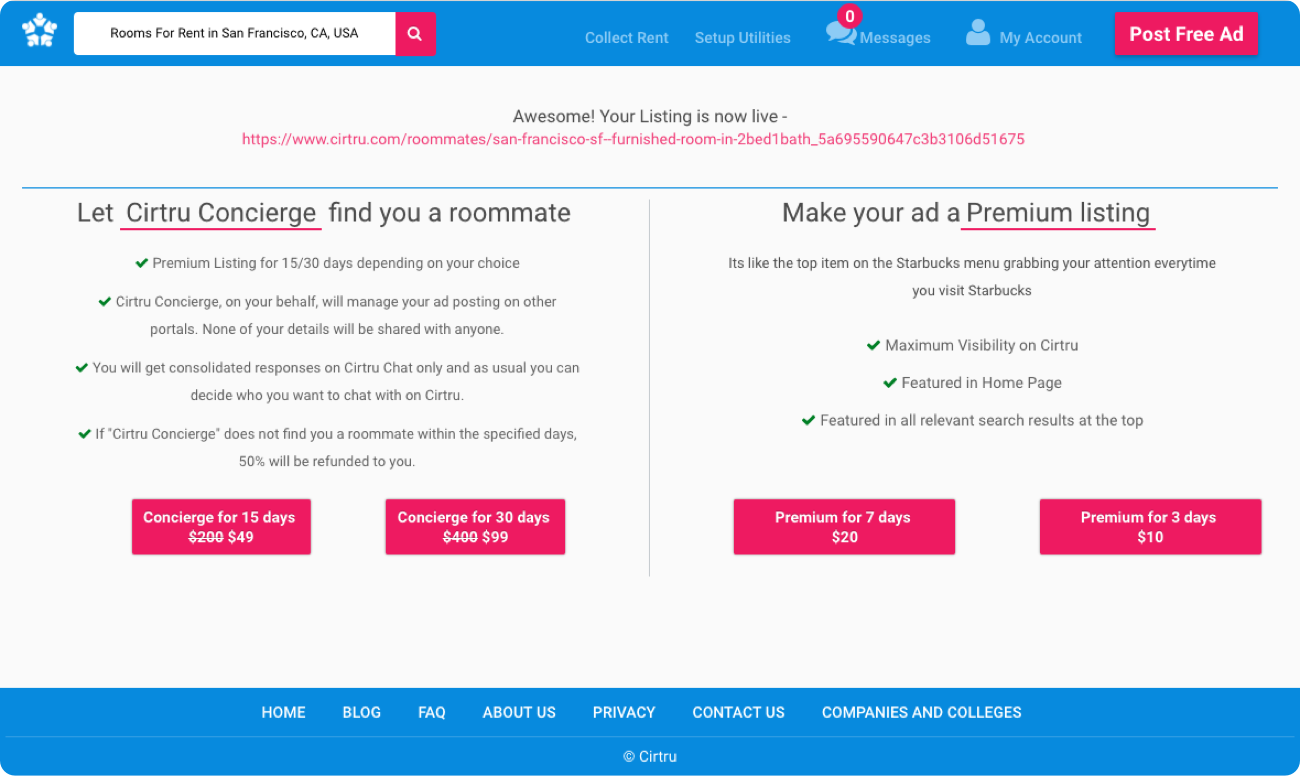
我们的评论:
减少客户的决策疲劳
您要求用户在此处做出重大决定:礼宾或贵宾列表。它们对应于不同的目标客户。
其核心理念是:有些人只需要一个能睡觉的地方,有些人则要求居住品质,对租金不敏感。后者期望的结果是“找个靠谱的室友,他不会逃避房租或在我睡梦中谋杀我。”
我可能有明确的定位选项:
给我找个室友。/我想自己跑腿找室友。
我会默认人们使用第一个选项,然后要么淡化第二个选项的细节(通过将它们变灰或其他方式),要么隐藏它们,直到有人与向下销售选项互动。
这让我在做出决定时无需花费太多心思:
“我要您给我找个室友吗?”当然,这就是我来这里的原因。
“我们应该寻找多久?”
我对此的回答可能是“我不知道;根据需要尽可能长点,但我希望室友快点”,这向我这个用户暗示,我认为这项服务收费过高。您想收取费用。我不想花更多的钱让您用更多时间去寻找;我想多付点钱,让您享受更好的礼宾服务。对我来说,最好付给您一笔成功费。
我不知道您这样做是否可行。
多卖;少说话
我会尽量简化这些要点。请考虑以下内容:
- 我们管理您在 Cirtru 和其他门户网站上刊登的房源[大概是 Craigslist?请列出其名称。]
- 我们筛选沟通线索;您可以集中对所有内容进行分类。
- 您只和您想交谈的潜在客户交谈;您选择您的室友。
-
400250 美元(限时优惠)
Cirtru 保证:我们提供专业服务。如果我们在 15 天内无法为您找到室友,将退费 50%;如果在 30 天内无法为您找到室友,将退费 75%。
CoinTracker 案例研究
众所周知,消费者对价格很敏感,但有土豪不在乎价格。CoinTracker 就是一个很好的定价示例。该软件有助于加密货币持有者实现税务合规。
其原始定价:
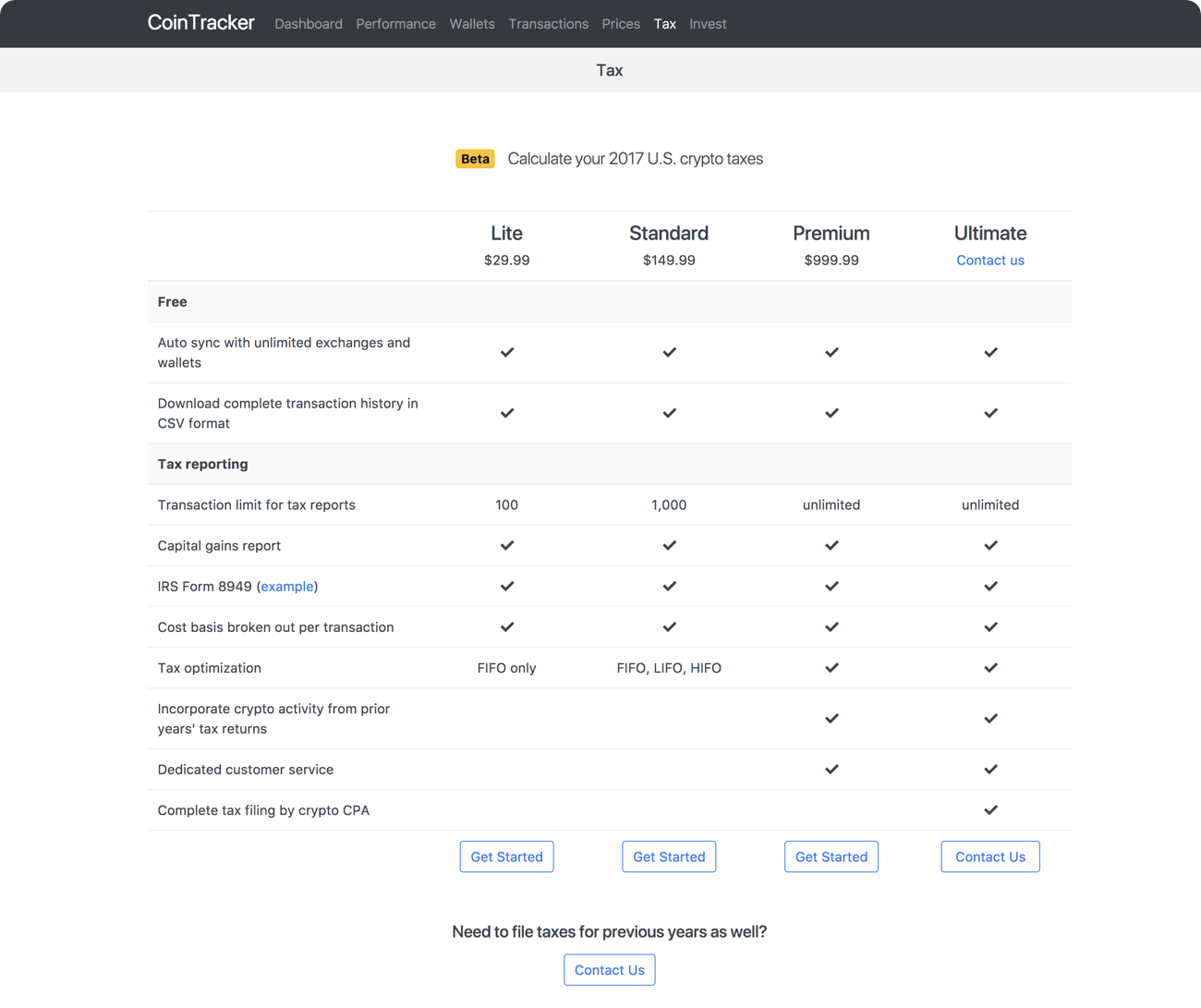
我们的评论:
在 B2C 中,正确定价是一项艺术
X.99 美元的定价通常不适用于企业对企业 (B2B) 或产消者(专业消费者)服务,因为它传达了廉价;出于审美原因,我建议您在这里去掉 0.99。(在我做过的一系列 A/B 测试中,没有哪一个测试能像产品定价为 49 美元、49.99 美元或 50 美元那样令人反感。尽管有几个客户坚持这样做,但我认为它真的不重要,所以还是去掉零头比较好。如果您的数据支持相反的观点,请相信数据。)
“简化版/标准版/高级版”作为 SaaS(软件即服务)计划的名称并不理想,因为它们无法帮助用户迅速判断哪个计划最适合自己的需求。我会考虑采用“业余爱好者/活跃交易者/金融专业人士”等名称。我通常还建议不要以 999 美元的价格购买无限制版。如果一家对冲基金找到您,说“哦,太棒了,我想在我的基金纳税报表中采用这个软件”,显然 999 美元的价格并不适合该用户。此类用户几乎肯定需要定制服务,999 美元显然不合适。
通常定价要高
大胆收取高额费用。您目前标有“高级版”的产品传达这样的价值主张:“收费 5000 美元的非专业会计师会漏洞百出,导致您支付数万美元的额外税款,然后接受审计,因为他的工作明显靠不住。您可以考虑使用我们的专业服务来精确报税,带来高品质的工作效益。”
我可能会将您的定价提高到 99 美元/499 美元/2499 美元。其目的是故意排除低端的病态客户,此类客户非常难缠。在我的印象中,这个市场充斥着大量低端病态客户,让您烦不胜烦。
如果一个人在 2017 年以加密货币进行了 1000 笔交易却没有赚到数万美元,那么坦率地说,这个人的决策能力有问题,别指望他会购买您的定制服务。
对高优先级客户服务要收费更高
“专属”客户服务是什么意思?这是否意味着低级别计划享受不到客户服务?这种表达方式可能不妥;我可以将其表述为“优先”客户服务。
顺便说一句,任何 SaaS 公司都可以轻松实现它 — 您只需明确这种客户的电子邮件地址,例如,在您的工单工具或 gmail 收件箱中添加标签,然后每天先处理带这个标签的电子邮件。这就是优先级的全部含义。
这可以诱使对价格不敏感的客户自行选择对价格不敏感的服务选项。许多 SaaS 企业家不喜欢此类优化做法。如果您确信自己的产品功能一切正常,则没有必要这样做;有钱人愿意为专享服务支付额外费用,他们不仅对您的公司这样做。他们可能与其他公司打过交道,不想再使用最廉价的服务,因为廉价服务的体验很糟糕。请告诉这些客户您可以提供高级服务,他们也乐意采用您的服务,这符合双方的利益,并且有助于您获得更多资金来支持其他计划中对价格更敏感的客户。
(如果您一直关注加密货币领域,可能会理解如果您提供的客户服务只是“请发送电子邮件至 /dev/null”,为什么许多投资者可能会不放心。在这个领域,明确回复电子邮件是一项差异化功能。)
向无差别的中小企业销售
SaaS 行业通常将非常横向的应用销售描述为“向中小企业销售”,尽管中小型企业 (SMB) 在各个政府机构都有更正式的定义,而不是“个人和知名公司之外都是中小企业”。
初入 SaaS 的企业家通常认为大部分 SaaS 都卖给了无差别的中小企业。这大概是不准确的;虽然有许多软件产品的销售确实横向度很高(跨各种行业、客户原型和目标公司的规模销售),但 SaaS 实际上是非常有针对性的。
这使得为中小型企业定价提供建议变得更加困难。您会看到,很多机会是利用定价/包装来帮助您努力加深对目标客户的具体了解并取悦他们,而不是对更多受众一视同仁,因为业绩平平。
FormAPI 案例研究
FormAPI(现在称为 DocSpring)使程序员可以轻松生成 PDF。
其原始定价:
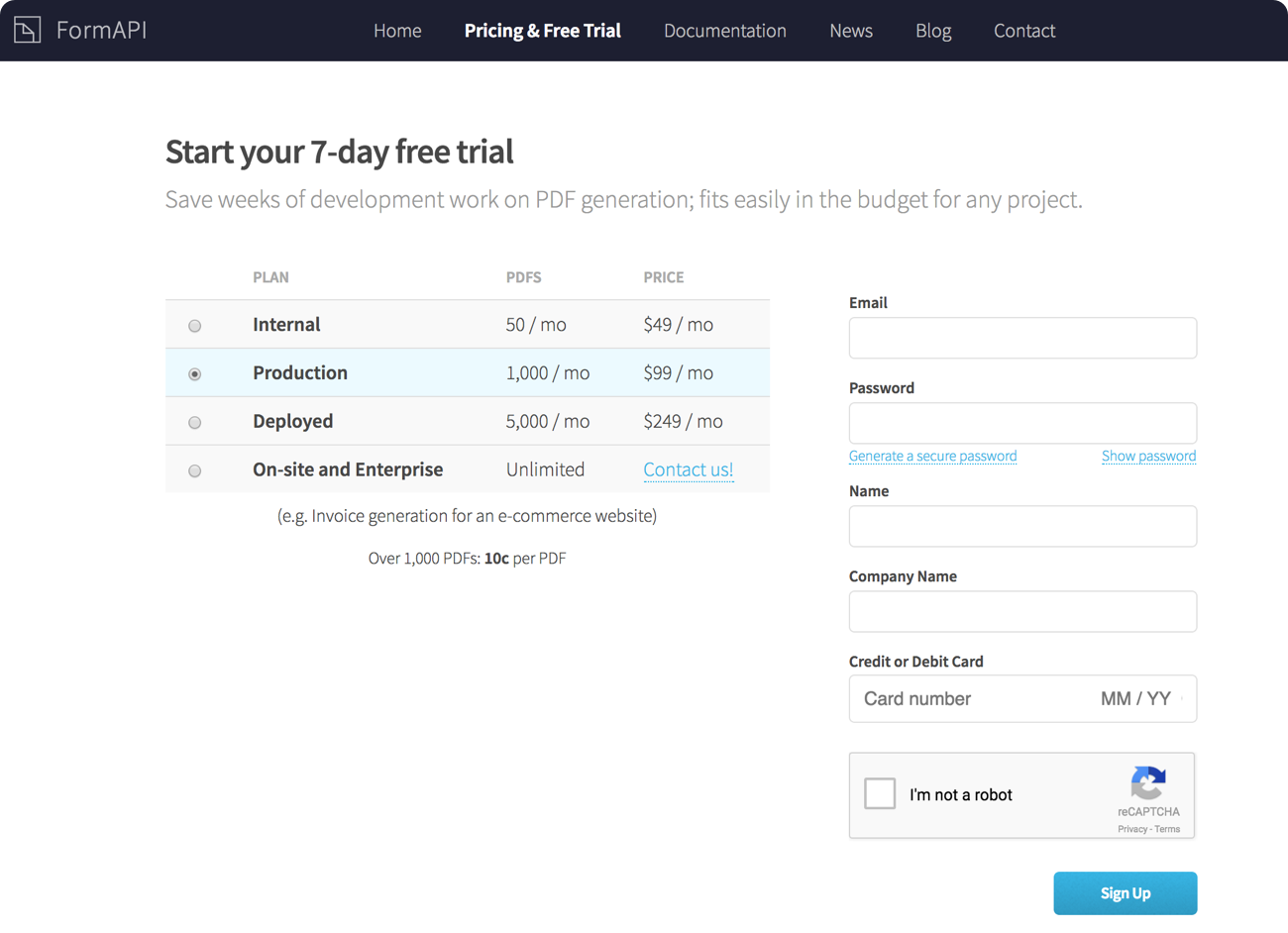
我们的评论:
面向技术用户的 SaaS 定价
注册页面上是否应该不应该提供信用卡表格?我发现大多数注册用户都会继续付费使用这项服务。如果我提供不需要信用卡的免费试用,这通常会带来更高的转化次数吗?
这个问题问得好。在初创公司的早期,不要求提供信用卡会降低初创公司早期的转化率,直到您在用户引导、应用内消息、生命周期邮件以及客户成功团队的直接触达等方面变得成熟。我不建议您在这次免费试用中取消信用卡的要求。
SaaS 应该有多少个计划?
您应该在注册时向用户公开一些决策。对于许多用户来说,预先预测他们的使用情况是具有挑战性的,因此您应该减少使用量之间的分级,并为计划命名,以帮助用户自行归类。
我数了下,有八个计划。我建议您将选项精简至三个,并在页面上展示“具体企业定价,请来电咨询”。倘若您的用户群体确实涵盖了所有这些类别,您可以展示三个主要方案,同时将其他方案保留备用;您可以在定价页面上隐藏这些额外方案,直至用户点击某个链接,或者采用轮播窗口形式展示方案(每次仅显示部分方案),等等。
例如:
您的定价页面应继续显示销售消息
从入门计划到现场和企业解决方案 - 选择最适合您的计划。
这里没有任何内容向用户承诺价值;这一切都与只有您关心的机制有关。相反,您应该重申 FormAPI 是做什么的,以及为什么他们选择的计划适合他们:
节省数周的 PDF 生成开发工作;轻松满足任何项目的预算需求。
向高端企业进军
您表达了希望以高感度方式尝试销售此产品的意愿。对于许多 SaaS 应用程序来说,这是一个自然的演变,这些应用程序开始以开发人员为目标,但发现自己被大型企业所采用。在您首次尝试向大型客户销售此产品的前几次接触中,您的目标不是要定出正确的价格;而是要深入理解用户希望从这款软件中获得什么,以及这对他们来说价值几何。然后在此基础上收费。
在对特定企业用户一无所知的情况下,我会假设对于大多数企业而言,这通常为他们节省 2 至 4 周的开发时间,按每月全负荷成本 2.5 万美元加上维护费用计算;因此,我可能开始向他们提供两种选择:
- 我们对提供的 SaaS 产品每年收费 1 万美元,可以为您托管,您也可以在本地使用
- 一次性许可费 2.5 万美元 + 每年 5000 美元的维护费,提供源代码;由您自行托管。
我会深入探讨他们对于支持服务等级协议 (SLA) 的期望;任何优于您为每月 500 美元账户提供的服务,都应在发票上单独列项,并且该项费用应为 1 万美元。
如果您发现 FormAPI 对于大型企业流程来说非常关键,您当然应该提高价格。如果一家保险公司围绕与供应商和监管机构之间的表单传输构建了整个业务,并且他们需要使用 FormAPI,则这笔业务收费不低于十万美元。
Humble Dot 案例研究
注意:在我们发布本指南一段时间后,Humble Dot 倒闭了。
Humble Dot 是一款多功能 B2B 应用程序,可帮助团队随时了解其他团队成员的工作内容。他们的定价如下:
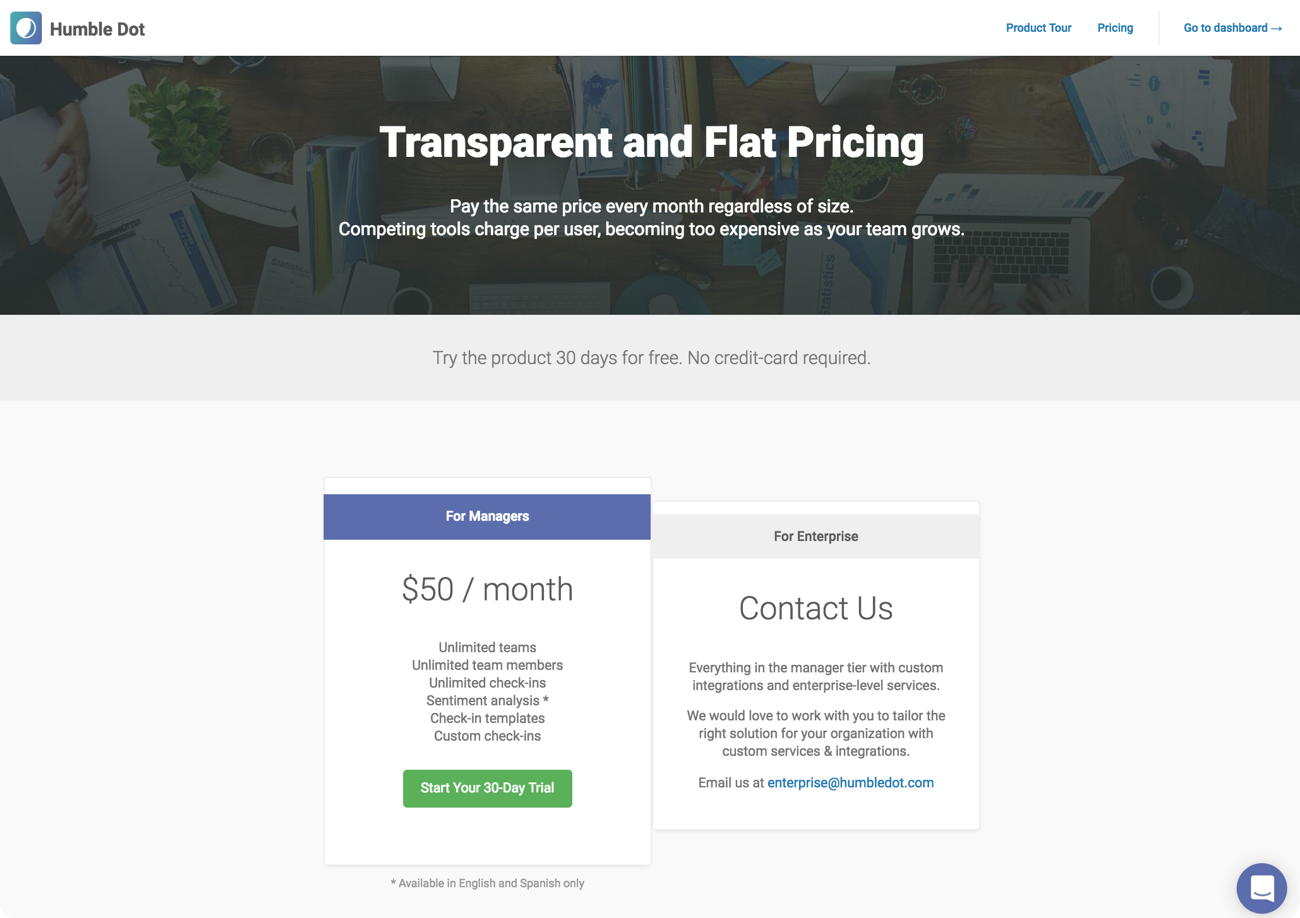
我们的评论:
我该亮出我的口头禅了:收取更高费用。
每月 50 美元并非此产品的合理最高定价,因为产品将在规模较大的企业中实施,用于管理专业团队,而任何值得专业人士反复投入精力的项目,其费用都不会仅仅停留在每月 50 美元的水平。Humble Dot 的最佳客户宁愿讨论是否花更多的钱买咖啡,也不实际购买产品;这种价值分配就本末倒置了。
定价页面应继续显示销售消息
Humble Dot 的定价页面彰显:
透明和统一的定价
我强烈建议您让定价页面的标题发挥销售代表的作用。您心中浮现出访问此页面用户的形象了,对吧?您能用一句话概括他们购买 Humble Dot 的原因吗?仅仅提供透明且统一的定价是不够的,因为我可以为您提供透明且统一的价格来购买物超所值的高级版,而您今天并不特别热衷于购买它。
我建议您尝试这样的标题:
与您本周的花费相比,我们的收费微乎其微。
同样,副标题也可以回应关于价格的异议。您知道我对定价有异议吗?我访问定价页面很可能是因为我对价格有疑问,而不是有反对意见。此外,这是一个非常小众的反对意见:如果我的公司发展到有 100 人使用 Humble Dot,这并不意味着对我来说成本是两人使用时的 50 倍;而是价值增加了 2500 倍,因为成对状态更新的沟通开销大约以 O(n^2) 的速度增长。
不要销售任何“无限”套餐
想象一下您能想到的使用 HumbleDot 的最大客户。“我们提供的所有服务每月仅需 50 美元,统一定义”,这一锚点如何影响您与该客户的定价讨论?它削弱了您为软件收取适当费用的能力。
一个相对较小的业务部门本季度未能达成目标,其影响可能达到数十万甚至数百万美元。这是您希望锚定企业销售的数字,而不是 50 美元。您可以费尽周折去争取“通常收费的十倍”,或者直面 B2B 销售的实际情况 - 即便是最基础的服务(如清理垃圾,以免员工亲自动手)起价也大约在每月 800 美元,因为对于一个规模足以负担办公空间的企业来说,低于这个数字的报价甚至不值得讨论。
我可能会为员工人数不超过 10 人的公司提供 50 美元的固定费率计划,超过这个人数,他们的最低薪资支出大概在每月 3 万美元左右吧?(假设:成本与美国相似的国家/地区的全职白领员工。)在那之后,每位员工 5 美元或 10 美元的费用听起来完全合理。您的最佳客户在员工填写更新信息上所花费的时间成本很可能超过这个数额 — 而这些更新能有多大的价值呢!
FirmA 案例研究
FirmA 是一家为企业自动进行财务业绩分析的公司,我们应他们的要求未显示具体公司名称。他们直接向最终用户销售,并以会计师作为销售渠道。
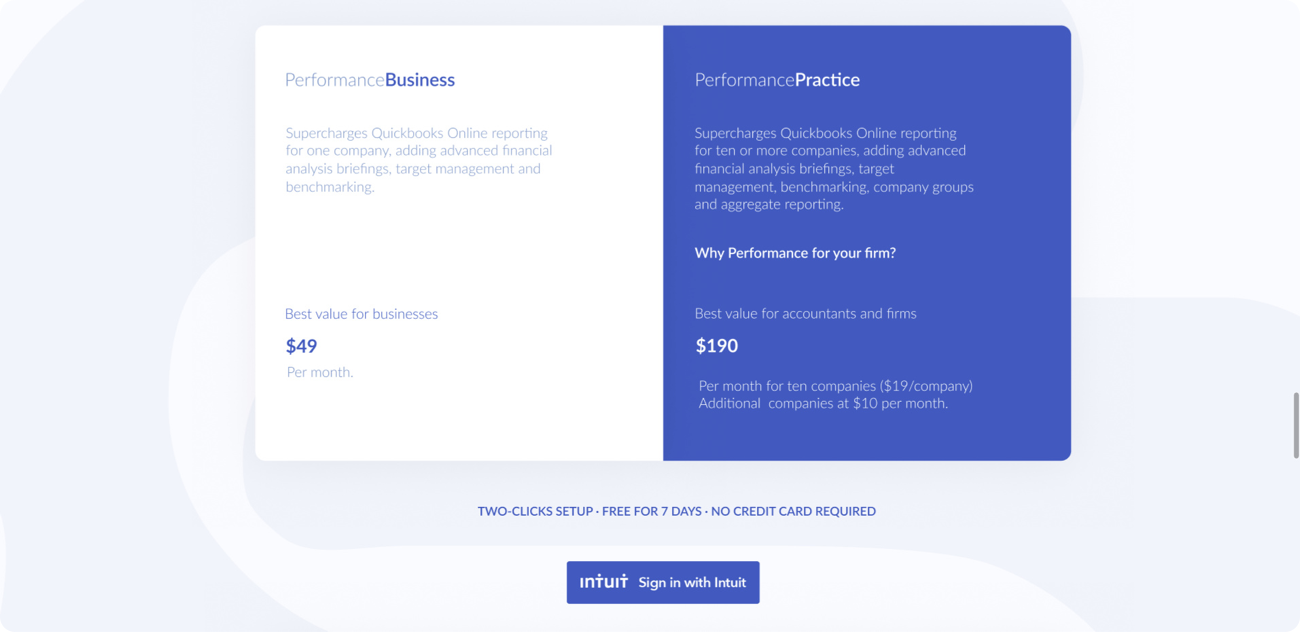
我们的评论:
尽量减少共享同一定价页面的不同产品
我可能会分别针对终端用户和会计师推广您的产品,使用两个独立的价格页面。您可以在每个页面之间互相链接,以防有人误入错误的页面。
这样做可以释放心理带宽和视觉空间,以便设置多个定价计划,这几乎是您必须考虑的事项。该产品在月营业额 1000 万美元的公司中创造的价值是月营业额 1000 美元的公司创造的价值的 1000 倍以上,对吧?您为什么要向他们收取相同的费用?
直接根据客户成功程度进行价格区分
我可能会以收入层级作为区分不同计划的标准:年收入 50 万美元以下、500 万美元以下、5000 万美元以下。
考虑到这些粗略的层级,我认为您的目标年度合同价值 (ACV) 可能在约 500 美元(您当前的定价)、5000 美元和 20000 美元以上。要达到更高的层级,您可能需要提高销售和服务交付的复杂程度,但将自己定位为能够服务于这些层级的企业,这会使入门级产品显得更加可信。
使用渠道策略
我欣赏通过会计师进行销售作为一种渠道策略的想法。(这种情况通常发生在 SaaS 公司向某一方销售产品,而该方与一批客户有关系,作为回报,该方通过这些关系销售 SaaS 公司的产品。通常情况下,这种合作模式会导致渠道方从最终用户支付的价格中抽取一部分作为佣金。)
您在这里并没有明确说明这一点:这种模式允许会计师除了提供利润率较低的服务工作外,还能从销售高利润率的软件产品中获益。
对于以前没有在咨询公司工作过的人,请注意:您可以将会计公司的利润率建模为大约 30%,因为会计公司需要支付员工会计师的工资和相关费用,而这些员工完成了大部分工作。当会计公司在发票上增加一个项目以便为客户提供访问您的软件的权限时,这个项目的利润率约为 80%。这对他们来说是一个非常有吸引力的追加销售机会。对于专注于中小型企业 (SMB) 的会计公司来说,他们的大部分计费时间都集中在报税季,而这种模式为他们在第二季度到第四季度提供了可计费的项目,同时也为他们提供了与客户保持联系的持续理由。服务型企业通常能够从提升其服务内容中受益,因为这可以增加他们与客户互动的频率。这不仅能提高客户满意度,还能创造更多后续工作的机会,并增大获得客户推荐的可能性。
正如这个例子所示,深入了解客户和/或渠道合作伙伴的业务有重大意义。这种了解使您能够对产品进行相对较小的调整,从而为他们创造巨大的价值。通常,这些调整对于能够快速编写代码的软件公司来说微不足道。例如,对于使用您的软件的会计公司来说,联合品牌或白标 PDF 报告可能非常有吸引力,因为这可以让他们的客户感受到定制化的、权威的指导,而无需花费专业时间进行高质量的一次性视觉设计。这个功能对于软件团队来说相对容易实现,但对渠道合作伙伴和最终用户来说却具有令人印象深刻的“惊艳效果”。
Vempathy 案例研究
Vempathy 帮助利用 AI 分析用户访谈和可用性测试中的情感内容。
他们现有的定价:
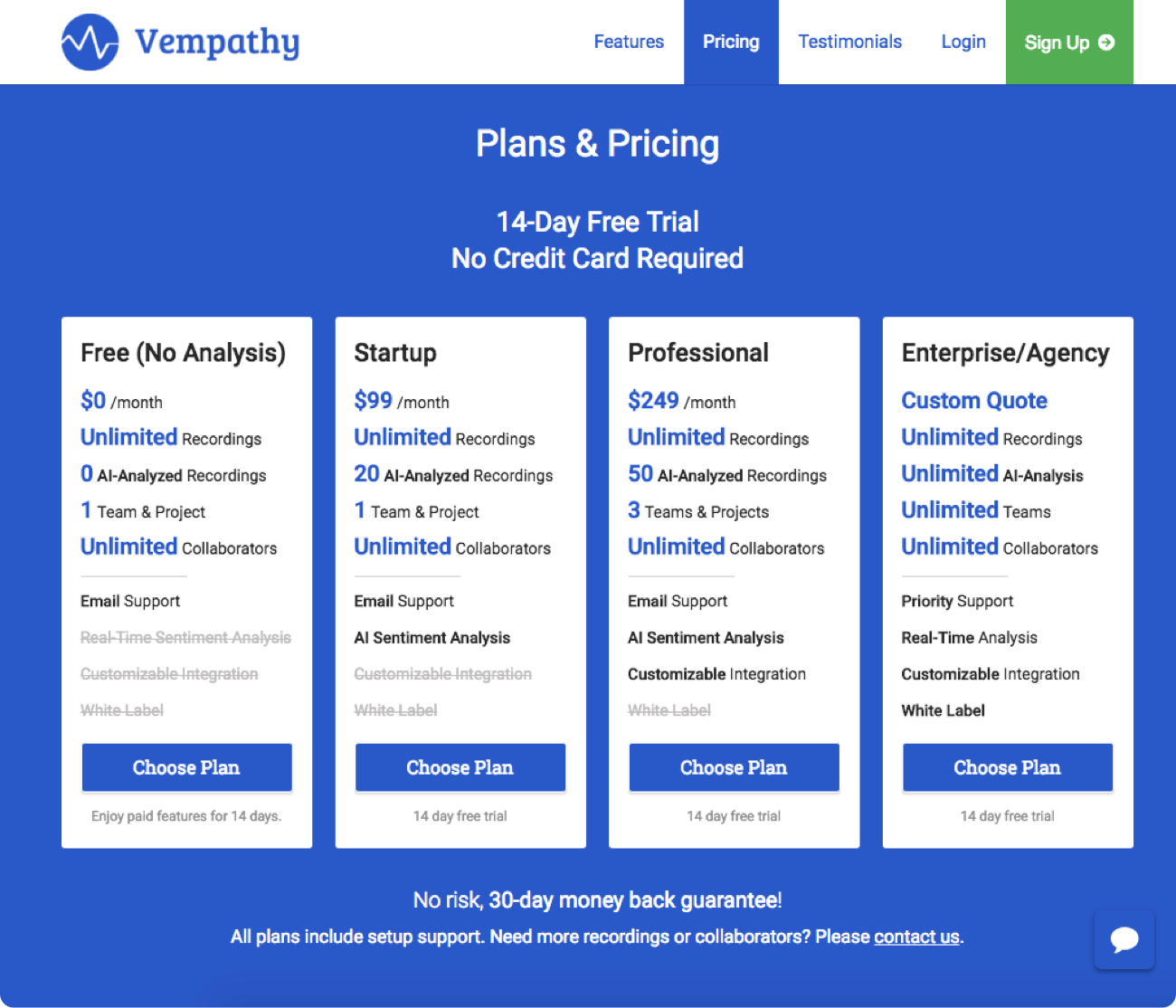
我们的评论:
小建议:没有人能在企业/机构版上“选择计划”。我更喜欢使用“联系我们”或“与我们沟通”作为行动号召,并在两种情况下将用户引导至联系表单。不应该为企业版提供 14 天免费试用;可以将演示嵌入销售流程中。
与其为免费计划单独设置一列,不如将其降级为文本,放在各列下方,视觉权重与“无风险,30 天退款保证”类似,是否可行?
考虑使用以下文案:*我们还提供一个不包含分析功能的免费计划,并将“免费计划”设置为超链接。
从定价页面中,客户是否能清楚地了解我们的收费内容?
我以阅读定价页面为生,但大多数用户的情况并非如此。话虽如此,您们的计划名称相当合理且具有描述性,因此我认为我可以根据这些名称为我的业务选择合适的分档。(我可能仍会稍作调整,但它们已经比“青铜/白银/黄金”好多了,后者会迫使我仔细阅读包含的内容。)
我建议贵公司的定价页面减少交易细节,更多关注如何赢得销售。
不要在定价页面上将其称为“定价页面”
“计划与定价”是对 SEO 友好的标题标签,不过我通常也会在其中加入产品名称。但“计划与定价”作为标题却相当糟糕;它占据了大量的视觉权重和用户的脑力,却未能通过提高转化率来证明其价值。您正在向 UX 设计师销售产品,而他们明确知道自己正在浏览定价页面;他们刚刚点击了一个链接或通过 Google 搜索,目的就是打开这个页面。
或许更好的标题(采用我在自己的软件公司中使用的有效风格)是:“只需[简明扼要地阐明您的价值]即可收回成本。”
例如:“通过分析一次 UX 实验节省的时间,即可收回成本。”您也可以使用其他更易引起用户共鸣的措辞。
试用门槛是否足够低?
如果是,我可能会考虑提高门槛。您如何传达这是一款由最专业的 UX 设计师和研究人员使用的高价值 AI 辅助情感分析软件?我会将风险降低措施(如免费试用、退款保证)降级为次要细节。
您认为定价分档的限制和价格点是否合理?
两个“无限制”选项中至少一个是多余的;我认为可以取消“无限制协作者”这一项,而不会影响绝大多数客户。您可以在页面下方为那些担心按席位付费的用户澄清这一点。
基于 AI 分析的录音数量作为主要定价轴是有意义的。我认为这比拥有多个团队/项目更有价值,因此我建议在定价表中隐藏团队/项目数量的限制,仅在软件中暴露这一限制。看看是否有人会触及这一限制。(如果客户抱怨在购买前未被告知,可以免费为他们升级。我预计没有人会在意,这意味着此限制不需要出现在定价页面上。)
我们是否应该包括详尽的功能列表?
它是否会促使某人决定购买软件?可能不会。相反,请继续传递销售消息:这款软件如何具体减少人工工作量,从而从用户录音中提取惊人的洞察力?将这一点放在页面上;并在适当的地方补充功能细节。
向特定垂直市场销售
通常,向 SMB 垂直市场(特定行业或客户类型)销售比面向所有 SMB 更容易,因为这样可以更精准地聚焦于他们的具体需求,了解影响其业务的因素,并使用用户熟悉的语言。
KitchenWhiz 案例研究
KitchenWhiz 为房主和木匠等专业人士创建厨房设计方案。
他们现有的定价:
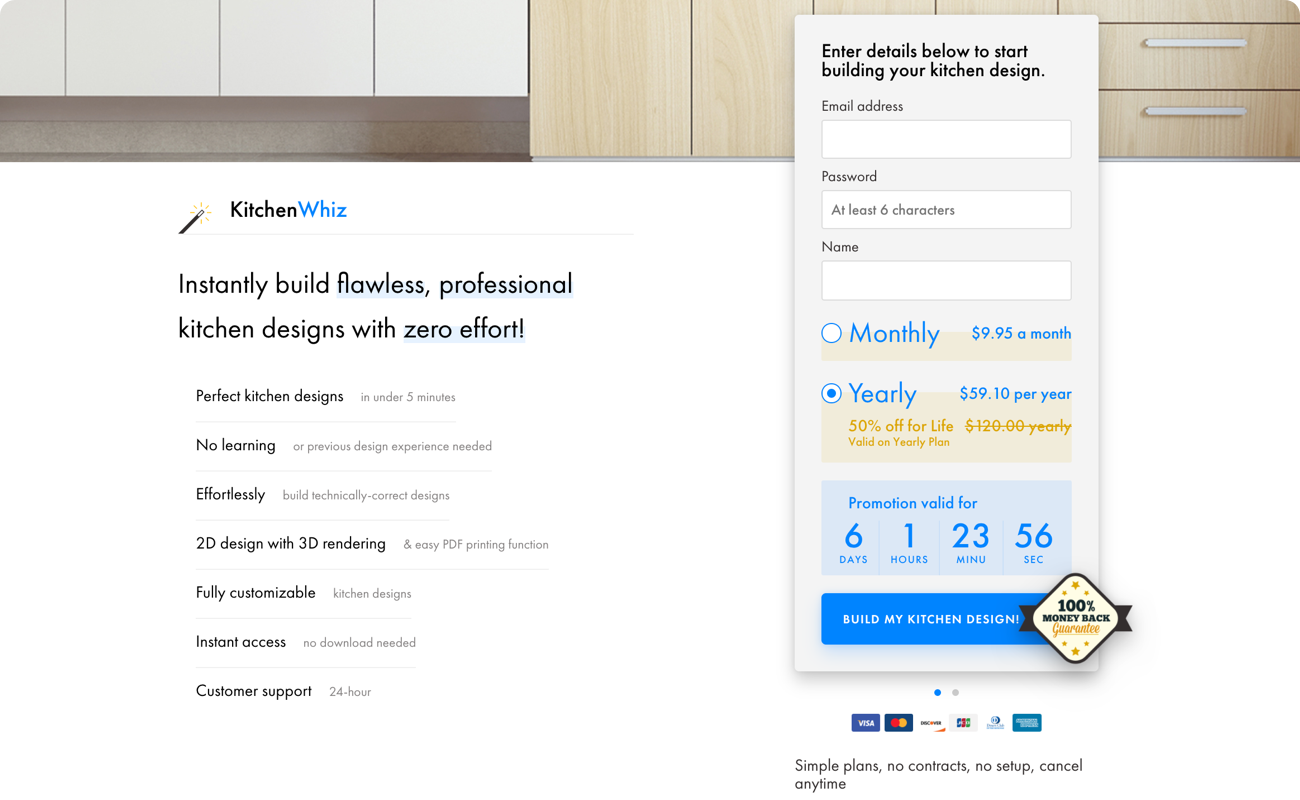
我们的评论:
SaaS 创业者往往高估了早期低价策略的益处
许多 SaaS 创业者认为他们的产品不如现有竞争对手成熟,因此定价远低于竞争对手。这几乎总是错的。
您的客户购买 KitchenWhiz 并不是因为它虽然不好但价格吸引人。他们之所以购买它,是因为您的价值主张是“它可以轻松生成设计精美、专业制作的厨房计划”。您的客户可能是从事装修行业的专业人士,而 KitchenWhiz 是他们业务中的一种创收工具。我鼓励您询问客户一次典型的改造工程通常花费多少;我怀疑他们在材料浪费上的支出可能都超过了 KitchenWhiz 在您考虑的任何价格点的费用。
它已经是为客户创造收入的工具,并且您正在快速迭代产品,使其比现在更好。您应该在您认为您的成熟度之前定价;这让您能够在客户发现并使用您的产品时“逐步适应”新价格,并防止您在不久的将来不得不回去找他们要更多的钱。
我可能会为 KitchenWhiz 设计三种套餐,具体内容由您根据最佳判断决定。以下是我对低感度模式销售的 B2B SaaS 产品设定的默认价格点,这些价格点适用于多种公司和行业。
每月:49 美元/99 美元/249 美元
每年:与上述相同,但提供一个月的“免费”试用
如果您发现每月 249 美元的版本完全没有销量,那么您可以根据情况取消它,但我认为市场可能会让您感到意外。
需要注意的是,这个建议的定价是现有最高定价的 10 倍到 50 倍。这展示了当您拥有一款理论上可以被消费者或企业使用的产品时,专注于 B2B 市场的强大潜力。AppAmaGooBookSoft 正在努力说服全球客户,软件应该是免费的(或几乎免费),并通过极其有利可图的广告/硬件/电商等生态系统来补贴。这是一种难以对抗的市场预期。
如果您希望以可持续的方式为 SaaS 定价,您可能需要主要瞄准企业用户。
慷慨的退款政策对您有利
我通常建议以低感度模式销售的软件向不满意的客户提供退款。退款确实会导致短期现金流压力,但不满意的客户对您的业务构成的威胁远比这种现金流压力更大,因为未被察觉的不满会导致难以控制的客户流失。
您应该积极鼓励对您的服务非常不满的客户具体说明原因;如果这对您有帮助,可以将退款视为您支付给他们的一笔小额咨询费。
此外,对 SaaS 公司服务不满的客户总是可以将拒绝退款的决定升级到他们的银行。银行通常会站在客户一边,而不是您的客户,因为您不是他们的客户。在类似“他们承诺软件能做到 X/Y/Z,但实际上没有,所以我要求退款却被拒绝”的纠纷中,您很难胜诉。应对这种纠纷比与客户交涉或开发软件更浪费时间,即使您在描述软件时完全准确,您也可能不会赢。
是否提供演示?
您正在尝试在转化率和学习之间找到平衡,决定是否提供免费试用。我现在会优先考虑学习:向每一个开始使用软件的人提供电话沟通。用 80% 的时间了解他们的业务,20% 的时间向他们展示软件的重要部分。
您应该将这些电话用于客户开发和销售,而不是培训 — 如果他们有问题,记录下来,稍后制作截屏视频或类似内容,供所有人观看。
我可能会利用电话沟通和专属礼宾引导的机会告诉每个人,您当然会为服务收费,就像他们为自己的服务收费一样,但作为限时优惠,如果他们能承诺进行一次 15 分钟的对话,讨论软件为何不符合他们的需求,您将免除一个月的费用。
这实际上是一种产品演示,但将责任放在用户身上,让他们组织自己实际使用软件,否则会感到尴尬,这与典型的免费试用相反,免费试用只是“试试看,或者不试;随便您。”将一款软件产品彻底试用是一项实际工作,而作为习惯性早期采用者的软件从业者常常低估了这一点。您是在要求一位忙碌的专业人士改变他们的工作方式,针对实际项目,涉及实际客户,而这个客户有实际的厨房需要设计。如果您不在他们采用软件和流程的过程中进行项目管理,您可以合理地预期他们不会在试用期内有效地使用您的软件,从而使试用的任何好处都变得毫无意义。
这是免费软件试用中极其常见的失败案例;尽管没有向信用卡收费,但它们的成本比人们认为的软件成本要高得多。我们太喜欢免费试用了,应该更慎重地考虑提供试用是否符合我们业务或客户的利益。
Publica 案例研究
Publica 帮助作者在线销售数字出版物。他们目前的定价:
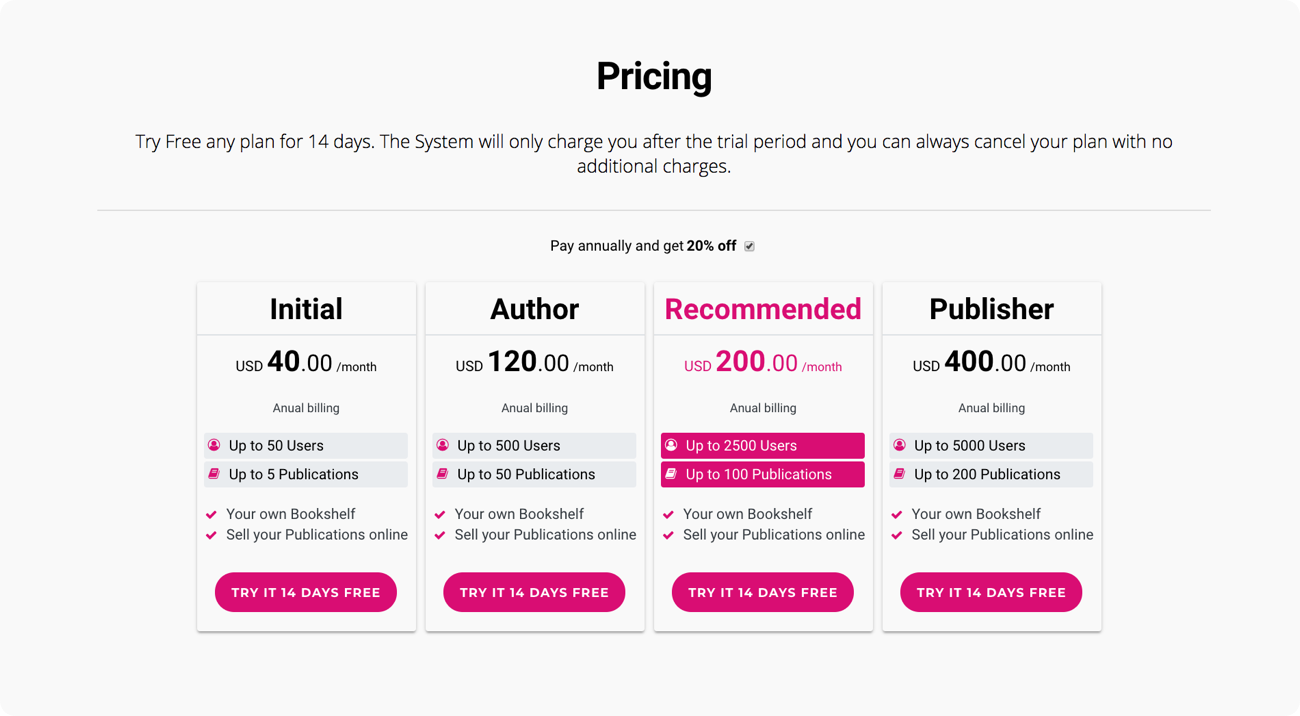
我们的评论:
为定价计划命名,以吸引合适的用户
定价页面上计划名称的唯一目的是适当地推动合适的客户,使其选择特定的计划。
如果您想到那些为了赚钱而在网上发表作品的作者的复杂程度,我认为“初始”这个名称可能无助于任何人做出正确决定;我会称这个计划为“业余爱好者”,因为这既可以帮助那些尚未卖出第一本书的人选择该计划,也可以帮助那些以写作作为主要职业身份的专业作者避免选择最便宜的计划。
“作者”是一个更好的名称,但可能还不够出色。您觉得“Professional”(专业版)、“Professional Author”(专业作者)或“Midlist Author”(中档作者)怎么样?(Midlist 是传统出版中的一个艺术术语。)
将计划标记为推荐通常会增加选择该计划的人数,但我可能不会将该计划命名为“推荐”。我可能会将其描述为一个印记(如果我怀疑我的客户是传统出版作者或情感上与之相关)或暗示小型企业的名称(例如“Cottage Publisher”)。
您问:
目前,我们为任何潜在客户提供 14 天的免费试用期,但我们仍然要求客户提供信用卡才能开始免费试用。我们是否应该取消这一要求?我担心这样做可能会增加试用数量,但试用者的质量可能会降低。
您几乎肯定是正确的:大多数 B2B SaaS 公司发现,取消信用卡要求会增加免费试用注册量,但会降低激活率(实际使用软件的用户数量)和付费转化率。在公司生命周期的早期,这样做通常并不值得。(您的企业需要在运营上具备相当复杂的能力以培养客户激活,然后在试用后期说服他们提供信用卡信息,这样才能取得净收益。)
我们的计划有很多功能;我们应该把所有功能都放在定价列中,还是只放重要的功能?
您应该只在定价页面上包含最突出的细节。如果计划之间的差异对您的客户或您来说并不突出,则无需区分计划;这会为您增加工程工作量,并为客户带来挫败感,而没有实现功能差异本应实现的目标,即说服人们为软件支付更多费用。
我们需要在每个计划中提供不同的功能,还是只需要限制最大使用量?— 例如,目前我们根据每个账户的用户数量和出版物数量收取月费或年费。
从根本上说,对软件收取不同金额的目的是不同的用户从软件中获得不同的价值,并且您希望从最不成功的用户和最成功的用户之间创造的价值差异中获取一部分。
关于定价页面的所有决策都是为了近似价值创造曲线并为其收费而进行的优化。
用户数量/出版物数量是对创造价值的近似值。使用更复杂的功能可能是另一种近似方法。是否有其他可用的近似方法?
我认为,对于出版平台创造的价值,最好的近似可能是它帮助客户赚取的金额,因此我可能会根据促成交易的数量或总额来收费。乔治·R·R·马丁应该比一位业余食谱作者支付更多费用,即使他们拥有相同数量的作品。
(相关:我认为你们的等级太慷慨了,如果我理解正确的话。)
我们有不同的客户,他们的需求也不同。为每个客户群体设置不同的定价模型是否可行?例如,对于出版商,我们根据他们拥有的出版物和用户数量收费。大学由于其运营性质,出版物数量非常多;我们只想根据用户数量向他们收费。
当然可以!较小的 SaaS 企业通常不会这样做,因为运营复杂,而且需要您了解不同的细分市场,但您完全可以设置“特殊学术定价”、“大学版”等。
您不需要差异化的功能集来证明这一点;这可能完全是一个营销决策。基本的见解是,大学的激励机制与营利性出版商非常不同,由于他们的激励机制不同,等同对待他们对任何一方都不太好。他们还可能会对不同的营销信息做出反应,未来会有不同的功能需求,并且在与您合作时会有不同的价值主张。对软件进行不同的打包有助于您发现并解决市场中的这些差异。
FirmB 案例研究
FirmB(应要求隐去其名称)销售一款 Shopify 插件,帮助电子商务企业优化其转化率。
其原始定价:
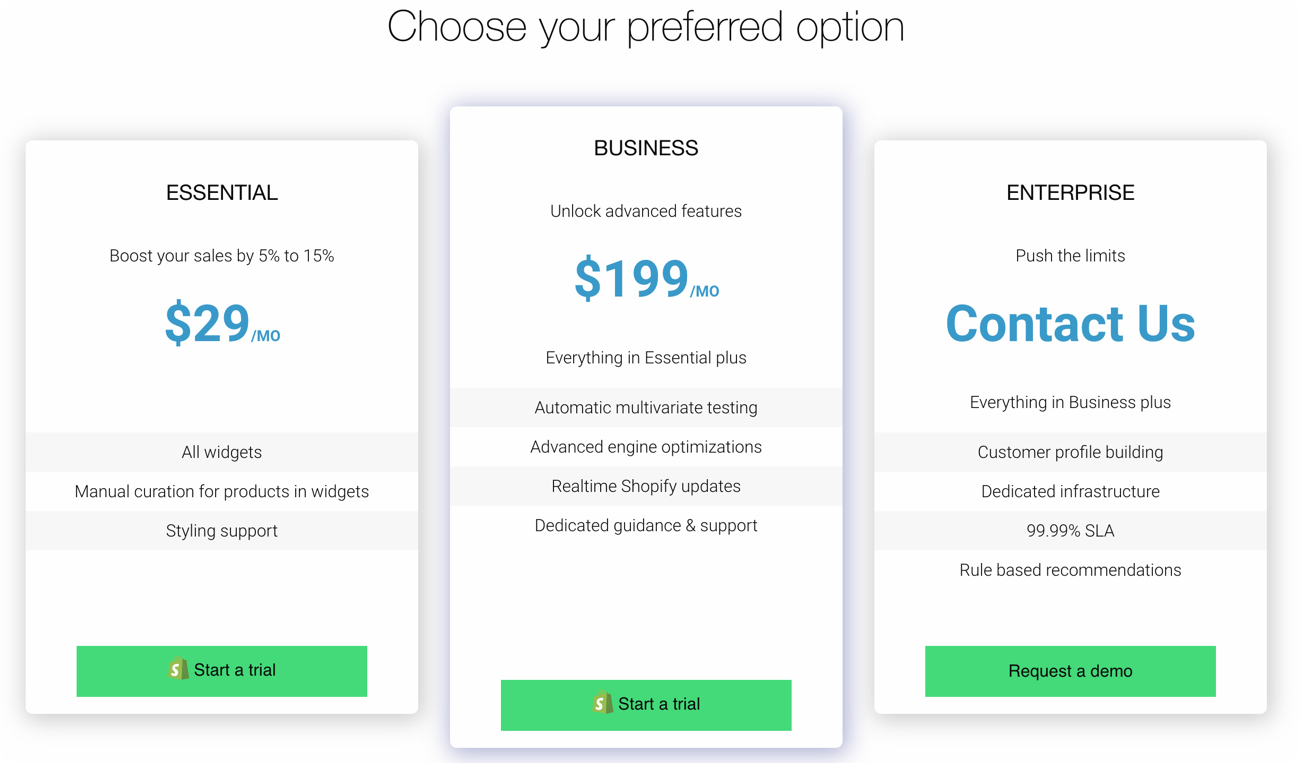
我们的评论:
我会以稍微不同的方式命名这些计划:也许是小型商店、成熟电商零售商、企业版等。谁会反感说自己是“成熟”的商家呢?
将价格锚定在专家成本上
企业购买的是好处,而不是功能,因此“解锁高级功能”不太可能说服某人从基本版升级到商业版。
我可能会这样定位:就像拥有自己的自动化 CRO 机构,但成本极低。
您知道电子商务公司为转化率优化 (CRO) 专家支付多少费用吗?我对该行业的典型价目表有一定了解。当我为软件公司做 CRO 时,我每周收取 3 万美元。这可能高于大多数 Shopify 托管公司的价格点,但他们肯定不会只为每次服务支付几百美元。因此,我会提高商业版的价格,并在销售材料中明确将其与雇佣 CRO 机构(最低投入是每月 5000 美元)或为团队增加一名 CRO 专家(即使是相对未经验证的初级员工,每年的总成本也不低于 10 万美元)进行比较。
顺便提一下,新企业主通常不会正确计算员工时间的真实成本。假设一名白领员工的总成本约为其标称工资的 140%;这是一个足够好的近似值,可以用来将 SaaS 定价与其真实的全成本(而非工资)进行比较。企业必须为全成本做预算,包括税收、福利、社会保险计划的强制缴费以及管理费用。
在与员工成本进行锚定时,使用他们的真实全成本而非名义成本(工资数字)对您更有利。
有效定价捆绑套餐
我认为您实际上提供了一种套餐,其中捆绑了多个在 Shopify 上流行的独立产品,对吗?我考虑将您的基础版定价提高到 49 美元,然后提供一个不太显眼的(不是一列,而是主定价表下方的文本选项)入门计划,价格为 29 美元,该计划只允许使用一个插件(任何时候)。这让注重价格的公司得以涉足,而不会切断大部分电商商店的收入,这些商店实际上是支付医疗保健和一切费用的合法企业。对于这些企业来说,29 美元和 49 美元之间的差异微不足道,但一旦您签下了数百家这样的企业,这对您来说肯定不是小事。
我会立刻把价格定在 199 美元到 249 美元之间(因为用户认为它们没什么差别);在您展现通过专属礼宾引导等方式提供的价值后,我可能会给它定价更高。
专属礼宾引导培训
想大幅提高中端计划(如您描述的“商业版”)的转化率吗?提供与产品捆绑在一起的免费咨询服务,重点是让某人成功开始使用;这通常被称为“专属礼宾引导”。如果您担心所需时间太多,您可以限制只有选择年度计划的公司可享受此服务。(您应该提供年度计划。)
专属礼宾引导使您的用户更有可能成功转化并取得更好的效果(因此他们更不容易流失)。此外,在业务早期,它为您提供了与客户交谈的绝佳机会,确保您在构建正确的功能、培训材料和工作流程来满足他们的需求。
它还为那些对价格不太敏感的人提供了一个选择更高层级产品的理由。如果我每月赚取 50 万美元的高利润销售额,但只是不够成熟,不知道什么是多变量测试,该怎么办?专属礼宾引导帮助我与你们进行详细对话,你们通过设置插件来自动增加我的销售额,从而提供了巨大的价值,同时也有机会向我推销多变量测试的价值。这是双赢局面。
销售给成熟的企业
成熟的企业通常更有能力为 SaaS 付费,因为合适的 SaaS 能为他们的业务创造更多价值。这与 SaaS 的复杂性、“秘方”程度或实际功能无关。
因此,直接面向成熟企业销售的 SaaS 公司应该比面向更广泛 B2B 市场的公司定价更高。跨多个垂直领域销售的公司应尽可能根据复杂业务细分出成熟企业,并打包产品,以他们习惯支付的高价提供优质服务。
Geomodelr 案例研究
Geomodelr 向石油和天然气行业销售产品。他们现有的定价:
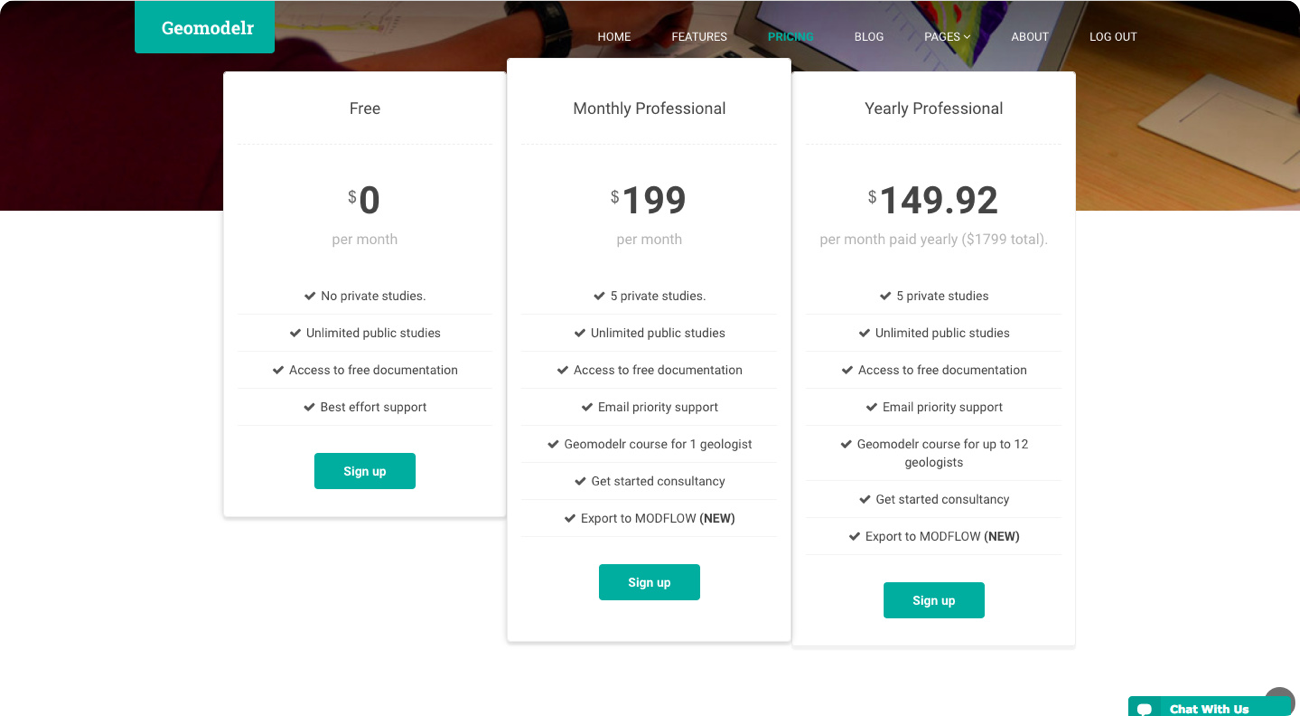
我们的评论:
对于资金充裕的买家来说,免费不是令人信服的价值主张
历史上,很多公司提供免费或几乎免费的软件,以期望软件尽可能广泛传播。然而,这在销售 B2B 服务时效果极为有限,因为价格通常是价值的代名词,尤其是在那些资金充裕的精明客户所在的行业中。
“免费”是否向石油公司传达了您的报告生成的数据/分析等足够可靠,可以用于 X00 万美元的资本投资或 Y 百万美元的矿权租赁?免费是否符合矿业公司决策者的价值观?他们是否希望获得免费的会计、法律或保险?
我会立即停止免费版本。向现有的免费用户发送一封电子邮件,告知他们您已停止提供免费服务,您将永远尊重他们的定价,作为对他们在公司早期忠诚的特殊奖励,您将给予他们付费版本 20% 的折扣。
未来,虽然您可以策略性地使用有限的免费试用,但您可能不应该再提供可商业化的免费服务。
如何呈现年度定价
在传统的 SaaS 定价网格中,各列之间存在巨大差异。在各列之间做出选择需要您的客户做出重要决策。您应该尽量减少重要决策。
按月计费与按年计费不应该是重要决策。
您的大多数客户不应该因为现金流问题而主导他们的软件预算,因为他们是在资本密集型行业中的高薪专业人士,乐于为工程服务付费。我会将核心产品设为年度计划,并提供一个切换框来选择月度计划。
提供多个套餐
我们已经取消了您的免费计划,并简化了账单周期的决策,因此您的公司现在基本上只销售一个套餐。可能应该提供多个套餐,以便为那些从中获得大量价值的公司提供适当的激励,让他们告诉您“实际上,我从这里获得了巨大的价值”,同时说服他们支付比那些对您来说更无足轻重的公司更多的费用。
我可能会将核心套餐的价格调整为每年 2500 美元/每月 250 美元(这是多次提价的第一步),然后测试另一个价格点,即每年 10000 美元(不提供月度选项,或提供每月 1000 美元但按季度计费的选项,以减少您需要追讨的支票数量)。
更昂贵的套餐中应该包含什么?我不知道。我会从优先支持开始,然后看看客户的需求是什么。
考虑向上游市场进军,推出企业版
我可能还会增加一个企业版套餐,客户需要打电话咨询价格。在最初几次通话中,您应该专注于了解他们对企业版套餐的需求,以及您是否能够满足这些需求。(如果您不愿意这样做,可以打电话给您现有的付费客户;询问他们是否每年为任何软件支付超过 5 万美元,如果是,询问他们需要您提供什么才能让他们为您支付超过这个范围的费用。)
我们也可以为您提供帮助
无论您是在经营一家公司,还是尚在考虑创业,都可以告诉我们您有哪些挑战可以让我们帮助解决。如果您希望我们更详细地探讨某个主题,请发送邮件至 atlas@stripe.com。
